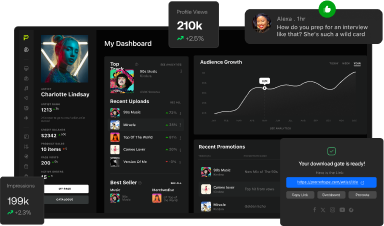
Understanding the structural rules of songwriting and composition is vital for driving the creative process when making music.
Using a song structure template can streamline this process, allowing songwriters to plan song lyrics, melodies, and other arrangements.
This guide includes templates for the most popular song structures, ready to use when composing your own music.
Get Early Access
To Promo Hype
What Is Song Structure?
The term song structure refers to the various sections that comprise a song, and how their arrangement forms a cohesive whole.
Popular song structures typically include verses and choruses, with intros and outros also used to bookend these elements.
Understanding song structure is crucial when learning to write a song that adheres to the principles of music theory.
Song structure provides a clear roadmap for writing songs, from instrumental sections to vocal performances and sound effects.
Using a songwriting template also helps with writing lyrics and structuring them to build an emotional and cohesive narrative.
Read more: Discover Promo Hype’s music distribution services.
Most Common Song Structures Elements
While there are various common song structures used in popular music, there are several core elements used in the songwriting process.
Here’s an overview of these elements found in common song structures for pop music and other genres:
- Intro: The opening section of the song, the intro, should establish the mood of the piece in a way that captures the listener’s attention.
- Verse: A ubiquitous song element when making music, the verse introduces the narrative theme through the lyrics, evolving over subsequent verses.
- Pre-Chorus: Some song structures use a pre-chorus, which serves as a transitional element leading into the main chorus.
- Chorus: A song’s chorus typically features the catchy lyrics and hook, using greater repetition compared to the verse.
- Bridge: Like the pre-chorus, the bridge section of a song helps facilitate transitions and adds variety to melodic arrangements.
- Outro: Like the intro, the outro is a comparatively short section that brings the song to a close.
Writing for each of these sections employs different approaches, influencing how the lyrics, melody, and harmony evolve as the piece progresses.
Importance Of Song Structure When Creating Music
While experimenting with melodies and harmonies can be a fun way to develop ideas, song structure gives these elements a cohesive form.
Here are some other compelling reasons for using a song structure template to guide your creative process:
- Guiding composition choices: Working from a song structure template makes it much easier to compose sections in the context of the entire piece. This attention to flow between sections can make the difference between a forgettable and an important song.
- Shaping a narrative: The sense of flow that a song’s structure brings to the table is also vital for shaping the musical narrative. How lyrics explore themes and emotions can be more clearly expressed when working with a song structure template.
- Enhancing musical variety: Understanding the compositional styles for the various sections allows songwriters to incorporate more variety into the piece. If a given structure isn’t working, different structures can be explored that lead to a more memorable song.
- Streamlining collaboration with other songwriters: Breaking down a song’s structure can help communicate ideas when collaborating on music. This structure can also be used when mixing music, adding notes to cover the desired effects, and adjusting other settings.
By learning the typical song structures, you can explore a range of creative options and fine-tune your songwriting skills.
Read next: The 10 best music producers of all time.
Song Structure Template
| Song Section | Themes and Lyrics | Instruments and Arrangements | Additional Notes |
| SECTION 1 | |||
| SECTION 2 | |||
| SECTION 3 | |||
| SECTION 4 | |||
| SECTION 5 | |||
| SECTION 6 |
A great song template provides the necessary framework for arranging music while still delivering enough leeway for customization.
This song structure template is designed to facilitate these goals, with the option to customize the sections depending on your project.
Here’s a breakdown of how to use this song structure template to maximize your songwriting workflow and achieve the desired results.
Song Sections
This column of the song structure template refers to the various sections that a complete song comprises.
For example, for the classic verse-chorus structure used in pop music, sections 1 and 2 will correspond to the verse and chorus, respectively.
You can repeat these section types down the left-hand column for as many cycles of verse and chorus you wish to include.
If you decide your song structure template needs to be modified to include an intro, outro, or other sections, add a new row.
These sections can then be viewed together to provide a bird’s-eye view of the overall piece and how they relate to one another.
Themes & Lyrics
In the next column on the template, you can note down any narrative themes or storytelling elements you want each section to cover.
This could be what the lyrics establish in the first verse, new themes in subsequent sections, and how the final chorus wraps it up.
If you already have the entire lyrics composed, you can break the song down and paste the lyrics into each specific section in the correct order.
Instruments & Arrangements
For the Instrumental Arrangements column, you can include a range of information, depending on your musical style and workflow.
This could include information on the song’s root key, as well as key changes that occur throughout a verse, chorus, and bridge structure.
It can also feature notes on specific instruments to be used, whether for certain sections only or throughout the complete song.
These notes can then be referenced when fleshing out the overall piece of music or using production tools in the editing stage.
Additional Notes
The final column in the song structure template is reserved for any additional notes that can serve as a point of reference.
You can use this section to add a note on how you want to set up the studio, ready for recording music across multiple sessions.
It can also be a handy column for passing on instructions to singers and musicians, such as recommended reference tracks.
Popular Song Structures For Beginner Songwriters
If you’re a newcomer to songwriting, you may be unsure which structural template to use as the basis for your first song.
Here are some song structures commonly used in popular music genres that you can apply to the above template and explore.
Verse-Chorus-Verse-Chorus
One of the most common song structures used in pop music is the verse-chorus structure, which offers a simple yet effective template for beginners.
While some artists apply their own songwriting formula to the structure, its traditional form has plenty of scope for development.
Lyrics in the first verse can establish themes, characters, and settings, with subsequent verses elaborating on the story.
The chorus is where your big hooks should land, such as the catchiest part of the lyrics and bright, dominant melodies.
Intro-Verse-Chorus-Verse-Chorus-Bridge-Chorus-Outro
Another widely used song structure template takes the verse-chorus concept and introduces additional sections throughout.
The intro and outro give the song more room to breathe, while the final verse-chorus-bridge adds another transition before the final chorus.
Using a bridge allows for more variety in melody and other arrangements that contrast with the previous chorus and final chorus.
Likewise, intros and outros make the song easier to mix, making them suitable for submitting to radio stations or using in DJ sets.
Get Early Access
To Promo Hype
Intro-Verse-Pre-Chorus-Chorus-Verse-Pre-Chorus-Chorus-Outro
This popular song structure template is widely used in pop and rock music, offering a variation on the previous arrangement.
Just as the bridge in the previous template serves as a build-up to the final chorus, in this version, the pre-chorus serves a similar purpose.
Since the chorus is often the most impactful and dominant section of a song, the pre-chorus is used to build anticipation and energy.
You can use it to introduce new instrumental elements that come to the fore in the main chorus and elevate the intensity with percussion.
Verse-Verse-Bridge-Verse
While many common song structures use a chorus, some eschew this section in favor of additional verses.
These extra verses enable songwriters to develop a narrative that incorporates catchier elements, with an emphasis on build-up.
Once the bridge is reached, contrasting peaks can be introduced as a pay-off, returning to the central themes in the final verse.
If you’re struggling with filling out the various sections of a song structure template, you can use AI music production tools to get inspiration.
Verse-Refrain-Verse-Refrain-Bridge-Refrain
For songwriting with a greater emphasis on storytelling, the verse-refrain approach can be highly effective in developing ideas.
There are notable classic rock songs that don’t have a chorus, and folk music from artists like Bob Dylan also employs this approach.
Sometimes referred to as the modified strophic form, it repeats the refrain to emphasize a hook and convey the central idea.
Again, the bridge section comes into play for building a sense of intensity and contrast, transitioning to the familiar refrain.
This structure is also notable for its high degree of adaptability, particularly when used for folk music that calls for elaborate narratives.
Each refrain can incorporate subtle variations in melody, harmonies, and arrangements that complement the lyrical progression.
Recommended read: What does a music producer do?
Essential Tips For Writing A Complete Song
If you’re entirely new to songwriting, it can be challenging to understand how to approach lyrics, melody, and harmony.
These tips will help you develop a straightforward structural approach and develop a listener’s ear ready to start producing music.
Learn Music Theory
Studying music theory is sound advice for writing songs across all genres, laying down the framework for all aspects of the process.
You can learn music theory for free through YouTube tutorial videos, or pay for in-person lessons while learning an instrument.
As well as teaching you about composition rules, music theory can include reading sheet music and expressing your ideas formally.
Combine Songwriting With Music Production
The distinction between songwriting and music production is often blurred, with many professionals applying both skill sets in their work.
All music production software features tools for composing songs, including the piano roll for composition and tempo control.
You can research the best DAWs for your musical style and use them to sequence your music based on the song structure template.
DAWs can also be used with free VST plugins, which replicate traditional instruments and provide tools for EQing and effects.
Experiment With Chord Progressions
Chord progressions can be powerful tools for introducing more complex harmonies and adding depth to the music.
While some music production equipment generates chord progressions, performing them on a keyboard will expand your horizons.
This includes experimenting with inversions and note positions, as well as advanced types of chords, such as non-diatonic chords.
Analyze Your Favorite Hit Song
An engaging way to master song structure is by breaking down how your favorite songs use the various sections.
Listening to music by the best music producers of all time will provide insights into how these sections can be elevated through sound design.
You can take notes on structure and sounds as you listen, and use online music deconstruction platforms for more information.
Learn From Music Industry Professionals
Learning from the pros is sound advice for any artistic endeavor, and many successful independent artists are happy to share their experiences.
In-depth interviews, tutorials, and studio gear breakdowns from industry professionals can all help with your approach to writing songs.
You can also attend a music production school for daily face-to-face lessons on writing songs and mixing the different sections.
Summary
Songwriting is an organic process that seeks to capture moments of inspiration and reflect them through lyrics and composition.
That said, a songwriting template ensures that your structure includes the appropriate sections to create an engaging and emotional journey.
As you become more confident in your songwriting skills, you can experiment with new structures that facilitate your creative expression.
Get Early Access
To Promo Hype
Join Promo Hype






